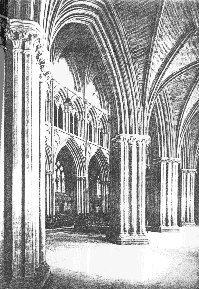
|
Changed Perceptions
Reflections on some English cathedrals
 One recollection of my childhood is of being taken to endless
cathedrals and churches by my father when we were on holidays or days out. This I usually
found fidget-makingly boring, considering even the smell of these old buildings unsavoury
and yearning for the delights of the shops and bustle of the streets. Rather perversely,
middle age has found me drawn back to these ancient places of worship when deposited in
various cities for two or three hours as Colin builds his business.
One recollection of my childhood is of being taken to endless
cathedrals and churches by my father when we were on holidays or days out. This I usually
found fidget-makingly boring, considering even the smell of these old buildings unsavoury
and yearning for the delights of the shops and bustle of the streets. Rather perversely,
middle age has found me drawn back to these ancient places of worship when deposited in
various cities for two or three hours as Colin builds his business.
Initially I remember arriving in York in deep turmoil with myself and finding the Minster a place to sit down and think. Gradually the size and space of the place allowed my thoughts to untangle and gain new proportion. I began to think of the builders of long ago, and to see their long term creativity. The transept destroyed by fire, recreated, showing that the old crafts were not dead with its fresh and new bosses reflecting the twentieth century. As my mind settled I began to see colour, bright and vivid, set against the York stone and rejoiced in it.
Southwell has also become a familiar friend. Previous recent visits had been followed by the patter of crocodiles of infant feet, whom I had enjoined to find the mouse on the communion rail, notice the eagle and name the animals around the outside of the chapter house. Now I see the majestic boldness of the ancient stonemasons. The confidence of the massive pillars in the nave and the absolutely huge amount of light and space one is drawn into as a midweek visitor. There I am reminded of my place in time and space, and given the courage to live my life with broader brushstrokes, secure in a solid faith to take a few more risks with life.
Lichfield is surprising. From outside I expected excess and heaviness, but to my surprise found softness and delicacy. Tints and shades of pink stone, beautiful grey blues and golds in stained glass. Bold yet intricate encaustic tiles in the chancel, and imaginative twentieth century silver chalices, again showing that the creative skills and crafts are still alive and fresh.
Fascinated by the differences in style of these various cathedrals, also by their common atmosphere of peace and security and insight into the larger scheme of things, I arranged a visit to Canterbury. Here surely would be grand space, the cream of Anglican creativity, a place of peace and unity. I queued to pay my entrance fee between Japanese and French school parties and worked hard not to be irritated by this almost irreverent and mercenary approach to a place of worship. Did I not understand the economics of maintaining ancient buildings, etc. etc. I walked in and, as is my custom, sat in the nave to breathe and look and think. Everywhere there was noise and bustle, around me was not space but staircases leading upwards and downwards, metal gates, wooden gates, low doorways and high, ornament and gilding next to solid stone buttresses. I was, to say the least, surprised. I attempted to find a quiet place to be and finally found it in a corner of the crypt. However, slowly I began to understand, here was everyone’s special place, the place they wanted to create for, the centre of things. And within it were all the people who had an interest in the Anglican communion.
As I walked around I noticed the stone floor, not uniform or particularly attractive, sometimes in small pavers, sometimes huge blocks of stone, sometimes set diagonally, not always I suspect even the same type of stone. But always polished and worn by the thousands and thousands of feet who had come to see, feel, find out, or seek comfort in that place. A smile must have played on my lips as I continued walking alone through all those people. Finally I found myself at yet another chapel where a notice on the wall asked that we might, if inclined, say a prayer here for those taken captive. Having recently read Simon Challand’s letter I thought of Florence, the laboratory attendant taken hostage. Willing my mind to concentrate as I still felt crowded and jostled, I stood completely still, and then as I turned to move, came face to face with a Buddhist monk in saffron robes.
I left not disappointed but with a feeling that I had encountered some sort of truth about the church and the Anglican communion. There are indeed "many mansions" but in all of them people search and many of us surely find.
Return to the Articles contents page
http://www.stpetersnottingham.org/misc/perceptions.htm
© St Peter's Church, Nottingham
Last revised 30th August 1998